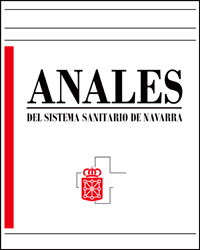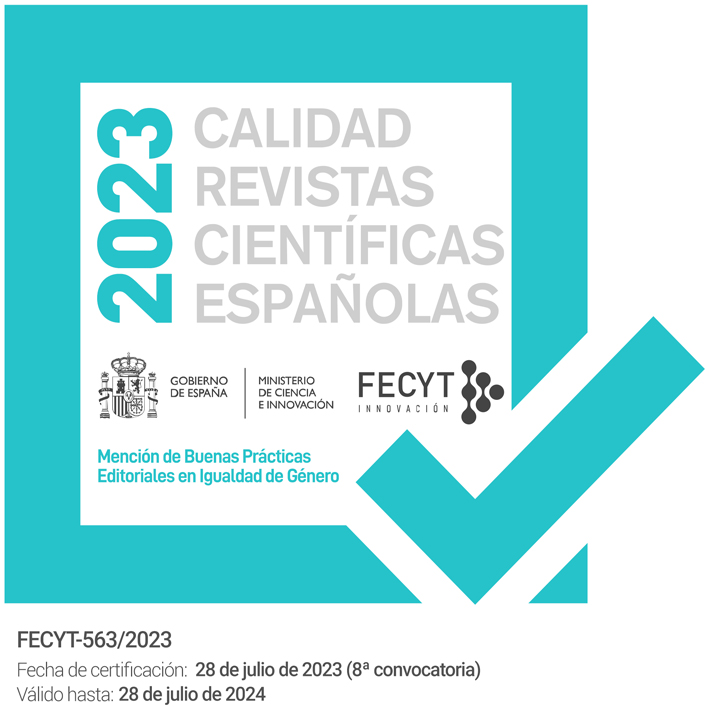Gonococcal pelviperitonitis: a diagnostic challenge
DOI:
https://doi.org/10.23938/ASSN.0931Keywords:
Gonococcal pelviperitonitis, Pelvic inflammatory disease, Acute abdomen, Differential diagnosisAbstract
Neisseria gonorrhoeae is the second most common etiological agent of pelvic inflammatory disease and is currently underdiagnosed due to its asymptomatic presentation in 50% of cases. When the disease presents, it may appear in the form of acute abdomen and normal imaging tests, making it a major diagnostic challenge.
We present four cases of acute gonococcal peritonitis. The main symptom was acute abdominal pain, and both the gynecological examination and complementary tests showed normal results. The only notable finding from the laparoscopy was the existence of purulent ascitic fluid. The results of the anatomical and pathological tests were all normal. Endocervical and ascitic fluid culture showed infection with N. gonorrhoeae, and in one case, concomitant infection with Chlamydia trachomatis. The definitive treatment applied was intravenous antibiotic therapy.
When a sexually active young woman is diagnosed with peritonitis that has no apparent cause, it is important to rule out sexually transmitted diseases.
Downloads
References
CURTIS AH. A cause of adhesions in the right upper quadrant. JAMA 1930; 94: 1221-1222. https://doi.org/10.1001/jama.1930.02710420033012
FITZ-HUGH T JR. Acute gonococcic peritonitis of the right upper quadrant in women. JAMA 1934; 102: 2094-2096. https://doi.org/10.1001/jama.1934.02750250020010
LÓPEZ-ZENO JA, KEITH LG, BERGER GS. The Fitz-Hugh-Curtis syndrome revisited. Changing perspectives after half a century. J Reprod Med 1985; 30: 567-582.
SATTERWHITE CL, TORRONE E, MEITES E, DUNNE EF, MAHAJAN R, OCFEMIA MC et al. Sexually transmitted infections among US women and men: prevalence and incidence estimates, 2008. Sex Transm Dis 2013; 40: 187-193. https://doi.org/10.1097/olq.0b013e318286bb53
Unidad de vigilancia del VIH y conductas de riesgo. Vigilancia epidemiológica de las infecciones de transmisión sexual en España, 2017. Madrid: Centro Nacional de Epidemiología, Instituto de Salud Carlos III / Plan Nacional sobre el Sida 2019. https://www.mscbs.gob.es/ciudadanos/enfLesiones/enfTransmisibles/sida/vigilancia/Vigilancia_ITS_1995_2017_def.pdf
MERTZ KJ, LEVINE WC, MOSURE DJ, BERMAN SM, DORIAN KJ, HADGU A. Screening women for gonorrhea: demographic screening criteria for general clinical use. Am J Public Health 1997; 87: 1535. https://doi.org/10.2105/ajph.87.9.1535
BABA Y, MATSUBARA S, TSUNODA T et al. Bacterial panperitonitis caused by Neisseria gonorrhoeae. Jichi Med Univ J 2006; 29: 187.
JOSHI RM, ALKHALEGY AA. Acute gonococcal Fitz-Hugh-Curtis syndrome. Int J STD AIDS 2012; 23: 39-40. https://doi.org/10.1258/ijsa.2009.009170
MITAKA H, KITAZONO H, DESHPANDE GA, HIRAOKA E. Fitz-Hugh-Curtis syndrome lacking typical characteristics of pelvic inflammatory disease. BMJ Case Rep 2016. https://doi.org/10.1136/bcr-2016-215711
BIGNELL C, ISON CA, JUNGMANN E. Gonorrhoea. Sex Transm Infect 2006, 82 (Suppl 4): iv6-iv9. https://doi.org/10.1136/sti.2006.023036
MULLER-SCHOOL JW, WANG SP, MUNZINGER J, SCHLAPFER HU, KNOBLAUCH M, AMMAN RW. Chlamydia trachomatis as possible cause of peritonitis and perihepatitis in young women. Br Med J 1978; 1: 1022-1024. https://doi.org/10.1136/bmj.1.6119.1022
MARAZZO JM, APICELLA MA. Neisseria gonorrhoeae. En: Bennet JE, Dolin R, Blaser MJ, editores. Mandell, Douglas, and Bennett,s Principles and Practice of Infectious Diseases. 8ª ed. Philadelphia: Elsevier 2015; 2580-2595.
WENTWORTH BB, BONIN P, HOLMES KK, GUTMAN L, WIESNER P, ALEXANDER ER. Isolation of viruses, bacteria and other organisms from venereal disease clinic patients: methodology and problems associated with multiple isolations. Health Lab Sci 1973; 10: 75-81.
BROWNING MR, BLACKWELL AL, JOYNSON DH. Increasing gonorrhoea reports not only in London. Lancet 2000; 355: 1908-1909. https://doi.org/10.1016/s0140-6736(05)73353-5
BOUSCARAT F. [Sexually transmitted infections. Current clinical and therapeutic data]. Med Mal Infect 2005; 35: 290-298. https://doi.org/10.1016/j.medmal.2005.03.003
WI T, LAHRA MM, NDOWA F, BALA M, DILLON J-AR, RAMON-PARDO P et al. Antimicrobial resistance in Neisseria gonorrhoeae: Global surveillance and a call for international collaborative action. PLoS Med 2017; 14: e1002344. https://doi.org/10.1371/journal.pmed.1002344
Downloads
Published
How to Cite
Issue
Section
License
Copyright (c) 2021 Anales del Sistema Sanitario de Navarra

This work is licensed under a Creative Commons Attribution-ShareAlike 4.0 International License.
La revista Anales del Sistema Sanitario de Navarra es publicada por el Departamento de Salud del Gobierno de Navarra (España), quien conserva los derechos patrimoniales (copyright ) sobre el artículo publicado y favorece y permite la difusión del mismo bajo licencia Creative Commons Reconocimiento-CompartirIgual 4.0 Internacional (CC BY-SA 4.0). Esta licencia permite copiar, usar, difundir, transmitir y exponer públicamente el artículo, siempre que siempre que se cite la autoría y la publicación inicial en Anales del Sistema Sanitario de Navarra, y se distinga la existencia de esta licencia de uso.








